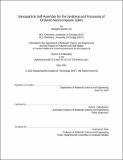Nanoparticle Self-Assembly for the Synthesis and Processing of Ordered Nanocomposite Solids
Author(s)
Lee, Margaret Sandra
DownloadThesis PDF (2.907Mb)
Advisor
Macfarlane, Robert J.
Terms of use
Metadata
Show full item recordAbstract
Nanoparticle self-assembly has emerged in recent years as a promising strategy for generating nanocomposite materials, with a focus on developing methods that are capable of controlling structure and composition at the nanoscale and ideally beyond, as natural nanocomposites have demonstrated how hierarchical ordering of constituent materials leads to enhanced properties in the composite. Nanocomposite tectons (NCTs) are a class of scalable nanoscale building blocks capable of self-assembly into ordered superlattices in solution through the use of dynamic supramolecular binding interactions. However, while dynamic interparticle interactions are key for enabling reversible binding and preventing kinetic traps during the assembly process, they render assembled structures susceptible to dissociation upon changes in the solution environment, limiting their processability outside of these narrow conditions. This work presents various methods for improving NCT superlattice stability and processability into polymer nanocomposites. These methods include the addition of free polymer to the assembly solution as a simple means to controllably increase the stability of nanoparticle superlattices against thermal dissociation in solution, as well as a method for embedding ordered nanoparticle superlattices into a polymer gel matrix, a medium that stabilizes the embedded arrays against disruption while still allowing dynamic lattice manipulation. Further stabilization can be obtained with complete solvent removal to bind nanoparticle arrays within a solid polymer matrix. The NCT design space is expanded by demonstrating a unary NCT-small molecule linker system capable of undergoing a reversible order-to-order phase transition between FCC and BCC, as well as demonstrating how solvent quality can be used to obtain ordered assemblies without the need for thermal annealing.
Date issued
2022-05Department
Massachusetts Institute of Technology. Department of Materials Science and EngineeringPublisher
Massachusetts Institute of Technology